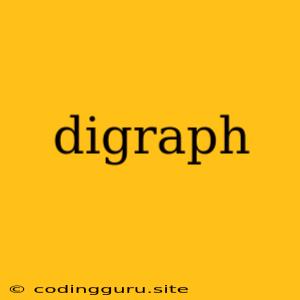Understanding Digraphs: A Comprehensive Guide
A digraph is a fundamental concept in graph theory that finds applications in various fields, including computer science, mathematics, and social networks. It's a directed graph, meaning edges or arcs have a direction associated with them, representing a one-way relationship between vertices. This makes them distinct from undirected graphs where edges connect vertices without a specific direction.
What is a Digraph?
A digraph, short for directed graph, consists of:
- Vertices: These are the points or nodes representing entities within the graph.
- Edges: These are the connections between vertices, represented by directed arcs or arrows. They indicate a specific direction from one vertex to another.
For instance, imagine a road network with one-way streets. Each street is represented by an edge with a direction, indicating the permitted direction of travel. In this case, the streets are the edges, and the intersections are the vertices.
Types of Digraphs
There are various types of digraphs, categorized based on their properties:
- Simple Digraph: A digraph without loops (edges connecting a vertex to itself) and multiple edges connecting the same pair of vertices in the same direction.
- Multigraph: A digraph with multiple edges connecting the same pair of vertices in the same direction.
- Mixed Graph: A graph containing both directed and undirected edges.
Applications of Digraphs
Digraphs find extensive applications in diverse domains:
- Computer Science: Representing data flow in programs, analyzing algorithms, modeling dependencies in software systems.
- Social Networks: Modeling relationships between people, analyzing social interactions, understanding information flow within a network.
- Transportation: Representing road networks with one-way streets, optimizing routes, scheduling transportation systems.
- Biology: Modeling gene regulatory networks, understanding biological pathways, studying protein-protein interactions.
Examples of Digraphs
Here are some real-world examples of digraphs:
- Website Structure: A website can be represented as a digraph where pages are vertices, and hyperlinks are directed edges.
- Airline Routes: A map of airline routes can be visualized as a digraph with cities as vertices and flight paths as directed edges.
- Dependency Graphs: Project management tools often use digraphs to illustrate task dependencies, where tasks are vertices and dependencies are edges.
Advantages of Digraphs
Digraphs provide several advantages:
- Directional Information: They represent relationships with directionality, providing insights into the flow of information, resources, or actions.
- Complexity Modeling: They effectively model complex systems with numerous interconnected components and dependencies.
- Visualization Tools: They offer intuitive visual representations, making it easier to understand and analyze complex systems.
Conclusion
Digraphs are powerful tools for representing directed relationships and analyzing various systems. Their applications range from computer science and social networks to transportation and biology. Understanding the concept of digraphs is crucial for comprehending the interconnectedness and directionality within networks and systems. By visualizing and analyzing digraphs, we gain valuable insights into the underlying structures and dynamics of these systems.
